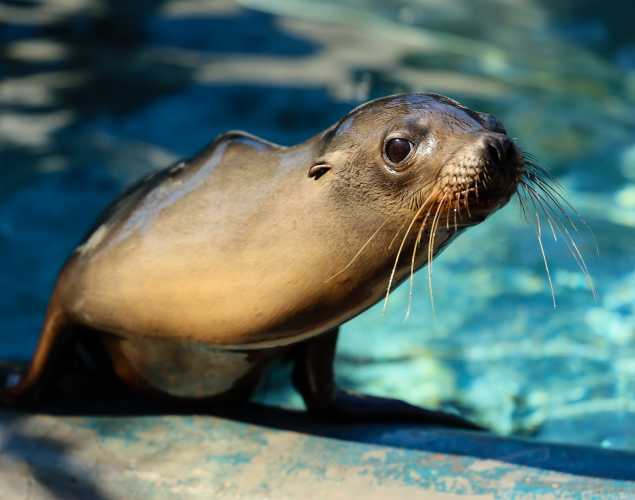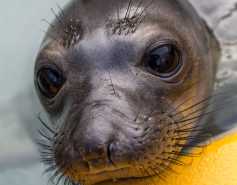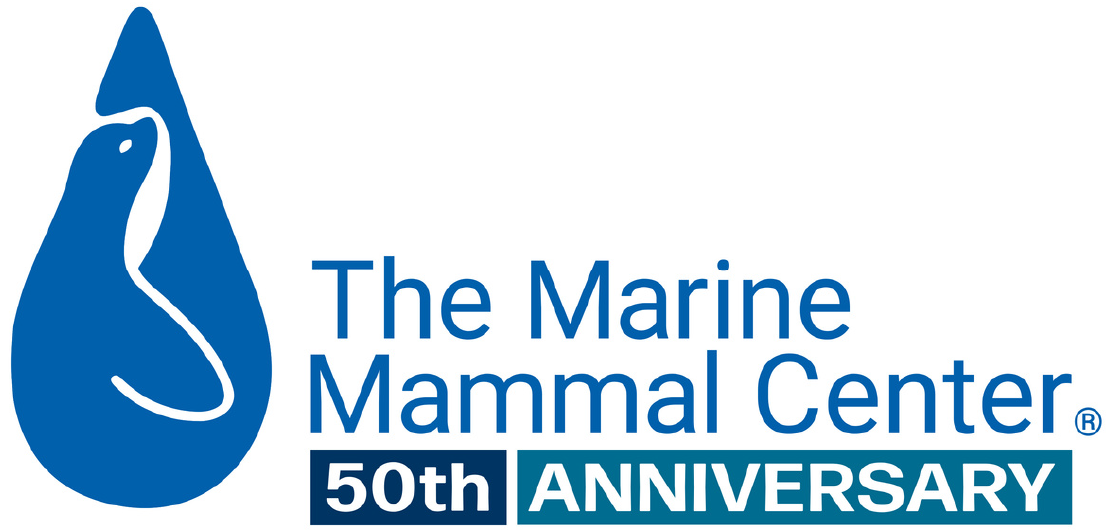
Development of Retrobulbar and Auriculopalpebral Nerve Blocks in California Sea Lions
- Medicine
Abstract
Eye lesions are commonly observed in pinnipeds. Clinical assessment is challenging because animals are often blepharospastic and under inhalant anesthesia the globe rotates ventrally, making observation difficult. Retrobulbar and auriculopalpebral nerve block techniques have been developed in other species to alleviate these difficulties and allow for a more thorough ophthalmic exam. Ocular nerve block techniques were developed for California sea lions (CSLs) (Zalophus californianus) using lidocaine hydrochloride 2%. To develop the retrobulbar block, a variety of needle sizes, anatomic approaches, and volumes of methylene blue were injected into the orbits of 10 CSL cadavers. An optimal technique, based on desired distribution of methylene blue dye into periocular muscles and tissues, was determined to be a two-point (ventrolateral and ventromedial) transpalpebral injection with a 20-ga, 1 1/2-inch needle. This technique was then tested using lidocaine on 26 anesthetized animals prior to euthanasia, and on one case with clinical ocular disease. A dose of 4 mg/kg of lidocaine was considered ideal, with positive results and minimal complications. The retrobulbar block had a 76.9% rate of success (using 4 mg/kg of lidocaine), which was defined as the globe returning at least halfway to its central orientation with mydriasis. No systemic adverse effects were noted with this technique. The auriculopalpebral nerve block was also adapted for CSLs from techniques described in dogs, cattle, and horses. Lidocaine was injected (2–3 ml) by subcutaneous infiltration lateral to the orbital rim, where the auriculopalpebral nerve branch courses over the zygomatic arch. This block was used in five blepharospastic animals that were anesthetized for ophthalmic examinations. The auriculopalpebral nerve block was successful in 60% of the cases, which was defined as reduction or elimination of blepharospasm for up to 3 hr. Success appeared to be dependent more on the location of injection rather than on the dose administered.
Gutierrez, J., Simeone, C., Gulland, F., Johnson, S. 2016. Development of retrobulbar and auriculopalpebral nerve blocks in California sea lions (Zalophus californianus). Journal of Zoo and Wildlife Medicine. 47(1): 236-243.
Related Publications
{"image":"\/Animals\/Patients\/Elephant seals\/cropped-images\/es-by-bill-hunnewell-c-the-marine-mammal-center-3-2-1214-3454-3512-1600891002.jpg","alt":"northern elephant seal","title":"Diagnostic Tests for Lungworm-Infected Northern Elephant Seals","link_url":"https:\/\/www.marinemammalcenter.org\/publications\/diagnostic-tests-for-lungworm-infected-northern-elephant-seals","label":"Research Paper"}

{"image":"\/Animals\/Patients\/California sea lions\/cropped-images\/csl-by-bill-hunnewell-c-the-marine-mammal-center-7-0-1446-2827-2208-1603918668.jpg","alt":"California sea lion on pool ledge","title":"Effectiveness of Antibiotics in Treating Leptospirosis in California Sea Lions","link_url":"https:\/\/www.marinemammalcenter.org\/publications\/effectiveness-of-antibiotics-in-treating-leptospirosis-in-california-sea-lions","label":"Research Paper"}

Effectiveness of Antibiotics in Treating Leptospirosis in California Sea Lions
Read More{"image":"\/Animals\/Wild\/Elephant seal\/cropped-images\/elephant-seal-bull-shutterstock-640-0-3728-2911-1626818513.jpg","alt":"large northern elephant seal on a beach","title":"Use of Potassium Chloride for Low-Residue Euthanasia of Anesthetized Seals and Sea Lions","link_url":"https:\/\/www.marinemammalcenter.org\/publications\/use-of-potassium-chloride-for-low-residue-euthanasia-of-anesthetized-seals-and-sea-lions","label":"Research Paper"}

Use of Potassium Chloride for Low-Residue Euthanasia of Anesthetized Seals and Sea Lions
Read More{"image":"\/Animals\/Wild\/Other species\/cropped-images\/weddell-seal-shutterstock-256-0-3788-2959-1639535584.jpg","alt":"Weddell seal laying on the ice","title":"A Safe and Effective Reversible Field Sedation Protocol for Weddell Seal Pups","link_url":"https:\/\/www.marinemammalcenter.org\/publications\/a-safe-and-effective-reversible-field-sedation-protocol-for-weddell-seal-pups","label":"Research Paper"}

A Safe and Effective Reversible Field Sedation Protocol for Weddell Seal Pups
Read MoreRelated News
{"image":"\/Animals\/Patients\/Elephant seals\/cropped-images\/es-hoffman47927-photo-by-bill-hunnewell-c-the-marine-mammal-center-124-0-1270-992-1748384535.jpg","alt":"An An elephant seal\u2019s face with long black whiskers and wide eyes emerges from the water. ","title":"Adaptations of the Deep: Seal Whiskers and Eyes","link_url":"https:\/\/www.marinemammalcenter.org\/news\/adaptations-of-the-deep-seal-whiskers-and-eyes","label":"Patient Update","date":"2025-05-28 02:00:00"}

{"image":"\/Animals\/Wild\/Elephant seal\/cropped-images\/01. SNI Andromeda_NOAA permit-174-0-1270-992-1733414759.jpg","alt":"A northern elephant seal with a satellite tag on its head on the beach in front of crashing waves. ","title":"Studying Elephant Seals of the Central California Coast","link_url":"https:\/\/www.marinemammalcenter.org\/news\/studying-elephant-seals-of-the-central-california-coast","label":"News Update","date":"2024-12-06 12:21:47"}

{"image":"\/Animals\/Patients\/California sea lions\/2022\/cropped-images\/csl-torple-by-bill-hunnewell-c-the-marine-mammal-center-6-10-4475-3495-1664989112.jpg","alt":"California sea lion Torple in a pool with her head in the air","title":"SFGATE: Hundreds of Sea Lions Sickened Along California Coastline","link_url":"https:\/\/www.marinemammalcenter.org\/news\/sfgate-hundreds-of-sea-lions-sickened-along-california-coastline","label":"In the News","date":"2022-10-05 02:00:00"}

SFGATE: Hundreds of Sea Lions Sickened Along California Coastline
October 5, 2022
Read More{"image":"\/Animals\/Patients\/California sea lions\/2014\/cropped-images\/csl-orchard-photo-c-the-marine-mammal-center-1350-74-2950-2304-1713994848.jpg","alt":"California sea lion Orchard","title":"The Curious Case of the Sea Lion That Couldn\u2019t Catch His Breath","link_url":"https:\/\/www.marinemammalcenter.org\/news\/the-curious-case-of-the-sea-lion-that-couldnt-catch-his-breath","label":"Patient Update","date":"2014-11-19 01:00:00"}

The Curious Case of the Sea Lion That Couldn’t Catch His Breath
November 19, 2014
Read More